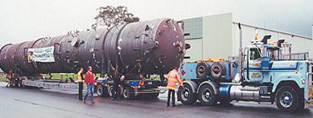
- (03) 5909 8218
- enquiry@fusionweld.com.au
What is a Hydrocracking Unit?
December 1, 2016

Most of us have heard of hydrocracking technology, but we haven't researched the term because it's a technology that's reserved for oil refineries. But hold on, the pressure vessel industry can't skip blithely past these units, not when they're responsible for handling intense mechanical stresses. What's generating this stress factor? More importantly, what is a hydrocracking unit?
Enter the Hydrocracking Primer
Intense forces are used to separate usable fractions from oil. This two-stage processing unit pushes that maxim to its limit by intelligently infusing the catalytic cracking cycle with large quantities of hydrogen. The catalyst then goes to work on the crude feedstock while in the presence of a hydrogen-rich atmosphere. What's the result of this twofold refinement cycle? Primarily, formally heavy fractions convert readily into usable distillates, fractions that exhibit purified chemical characteristics. Next, let's see where hydrogenation fits into this chemical soup.
Hydrogenation Purification
Yield maximization is promoted by this hydrogen-saturated environment. Previously heavy hydrocarbons convert readily, crack and separate to form desirable products, including diesel and kerosene. The hydrogenation mechanism now binds the free-floating hydrogen molecules to the leftovers, to the sulfur and nitrogen contaminants that taint the near perfect fuels. The resulting ammonia (NH3) and hydrogen sulfide (SF6) waste products are now easy to eject from the processing environment. High-quality diesel fuels are produced in this manner, as are the jet fuels that drive our finest aircraft engines.
From Zero to Hero
The amount of waste produced by a standard cracking facility represents a potential environmental hazard, but hydrocracking units eradicate the waste. They do so by transforming heavy hydrocarbons into high-quality fluid energy sources. And, not to be left out in the cold, the process embraces a high yield productivity model, which means all the nasty bitumen and hardened waste lining the inner surface of the vessel also become a part of the high-quality fuel solution. In putting the final tick in the final box, the recycling hydrogen also eliminates fuel contaminants by using a chemical mechanism known as hydrogenation.
Heat exchangers roast the inner chambers of the hydrocracking unit. Meanwhile, powerful gas compressors pump hydrogen into special processing sections. Due to these tough operating conditions, huge internal stresses are generated, but our hypothetical hydrogen-imbued unit safely withstands these challenging forces. This hydrogen-saturated product earns a premiere spot within an elite pressure vessel family. In return, low-sulfur, high-quality fuels are produced from heavy fractions, substances that otherwise would not yield a usable distillate.
Contact Details
Fusion - Weld Engineering Pty Ltd
ABN 98 068 987619
1865 Frankston Flinders Road,
Hastings, VIC 3915
Ph: (03) 5909 8218
Optimized by NetwizardSEO.com.au
Recent Posts
- Compressed Hydrogen Storage Vessels: Material Selection, Design & Australian Standards
- Welding QA/QC in Oil & Gas Pressure Vessel Fabrication – Ensuring Code Compliance
- AS1210 vs ASME VIII Pressure Vessel Code: Key Differences for Australian Projects
- Mitigating Hydrogen-Induced Cracking in Pressure Vessels: Engineering and Material Strategies
- Storage Tank Solutions Australia: Field-Erected, Prefabricated & Self-Bunded Explained
- Reducing Environmental Risks: Self-Bunded Tanks in Australian Oil & Gas Operations
- Precision in Production: How Pressure Vessels Are Manufactured for Industrial Safety
- Shell & Tube Heat Exchangers: Improve Thermal Control & Energy Recovery in Petrochemical & Pharmaceutical Plants
- In-Service Inspection for Compressed Air Receivers for Power Plant Shutdown Prevention
- Power Plant Pipe Spooling Fabrication – Get Rapid, Code-Compliant Spools Ready for Installation
- Field Erected Tanks: Safe, Reliable On-Site Fuel Storage Solutions in Australia
- Custom Pressure Vessel Fabrication for Flammable Gases
Posts 2025
- Compressed Hydrogen Storage Vessels: Material Selection, Design & Australian Standards
- Welding QA/QC in Oil & Gas Pressure Vessel Fabrication – Ensuring Code Compliance
- View all articles…
Posts 2024
- Large Process Vessels: Optimising the Design for Maximum Efficiency [2025]
- Pressure Equipment Management System Installation: Detect Equipment Faults Early
- View all articles…
Posts 2023
- Pressure Piping System Inspection: A Gift of Safety for the Holidays
- Deaerator Inspections by Fusion-Weld Engineering and How They Reduce System Downtime
- View all articles…
Posts 2022
- How Fusion Weld Keeps Up With AS-NZS ISO 9001:2008 Standard
- Boiler Equipment Safety Inspection During the Summer Season
- View all articles…
Posts 2021
- Avoid These Factors and Practices that Contribute to Sealing Damage in Pressure Vessels
- Do's And Don'ts Of Industrial Boiler Inspection And Maintenance From Fusion-Weld
- View all articles…
Posts 2020
- What are the Risks and Hazards Involved in Pressure Vessel Equipment?
- How to Know if Your Pressure Equipment Needs Repair or Replacement?
- View all articles…
Posts 2019
- Factors that Contribute to Pressure Vessel Failure
- Pressure Vessel Regulations in Australia: What are the Mandatory Requirements?
- View all articles…
Posts 2018
- Pros and Cons of Spherical vs. Cylindrical Pressure Vessels
- What are the Different Hazard Levels in Pressure Vessels?
- View all articles…
Posts 2017
- Transportable Pressure Vessels: The Importance of Inspection and Safety Checks
- Fracture Mechanics and Stress Analysis of Cracks in Pressure Vessels
- View all articles…
Posts 2016
Posts 2015
- What Are Deaerators & Feedwater Vessels?
- Precautions and Safety for Compressed Air Receiver Vessels
- View all articles…
Posts 2014
- Demonstrating In-process Inspection Procedures
- Static Grounding Practices and Standards
- View all articles…